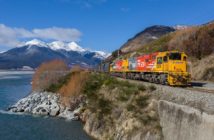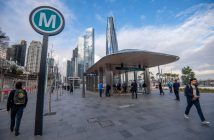KiwiRail is to employ an all-diesel fleet on the North Island Main Trunk line in a bid to “improve its reliability and efficiency for customers”.
The small fleet of almost 30-year-old electric trains that currently operate only between Hamilton and Palmerston North will be phased out over the next two years and replaced with diesel locomotives.
The electric infrastructure on the line will remain in place, however, and be maintained to a safe standard for “any future use”, KiwiRail promises
The North Island Main Trunk (NIMT) runs from Auckland to Wellington but is electrified only between Hamilton and Palmerston North.
KiwiRail chief executive Peter Reidy says KiwiRail is essentially running “a railway within a railway” by having the electric section.
“Imagine having to change planes at Hamilton and again at Palmerston North, just to fly from Auckland to Wellington,” he says.
“That’s not efficient, it’s more costly and ultimately delivers a less reliable service.
“The doubling up of service facilities, inventory, training and maintenance required with two separate systems on the line adds to the inefficiencies and unreliability.”
The decision took more than two years to make and included extensive consultation with international experts, unions and other consultants.
KiwiRail investigated four main options: replace the electric fleet with used or new electric trains; upgrade the current electric fleet or replace them with diesel trains as used on the rest of KiwiRail’s network.
The 16 electric trains were breaking down on average every 30,000 kms (rolling average), which is well below the fleet target of every 50,000 km. “Doing nothing was not an option,” Reidy insists.
Only eight diesel trains need to be purchased as other existing diesel trains can be used more efficiently to cover the work of the electric trains.
Efficiency was not the only factor involved in the decision – environmental factors were assessed alongside the driving factors of reliability and performance improvement for customers.
“This is an important move for New Zealand as without a reliable and efficient service, our customers will not move freight on rail and every tonne of freight moved by rail delivers a 66 per cent reduction in carbon emissions from road,” Reidy maintains. “That’s critical for our customers, and for the country.”
A small number of staff may be affected by the change but staff and unions will be consulted well before the phase-in begins.
“Our preference is always to redeploy our people where possible and the project will take up to two years to implement,” Mr Reidy says.
The decision to choose the diesel option wasn’t made lightly or hastily, Reidy assures. “We looked long and hard at the electric options and for our business, and most importantly our customers, they just did not stack up.
“Ultimately the high costs of a new or refurbished electric fleet couldn’t be justified, while the gains to be made from standardising our fleet were very compelling.”
The cost of electrifying the whole NIMT is estimated at more than $1 billion for the infrastructure alone and feeder lines would still require diesel trains.
Retaining the electric infrastructure leaves the way open for future use if required. “This is not a forever decision,” Reidy admits
“We should not lose sight of the fact that last financial year freight carried by rail in New Zealand meant 1.1 million fewer truck trips, 76.7 million fewer litres of fuel used, and 208,613 fewer tonnes of greenhouse gas emitted and that was with a largely diesel fleet.”
The decision has been slammed by the Green Party, which insists it’s a “backward step and bad news” for New Zealand.
“Many New Zealanders will despair at this short-term approach – it’s 2016, not 1916,” says Green Party transport spokesperson Julie Anne Günter. “National has promised to take climate change and transport issues seriously, but it’s underfunding of rail is responsible for short-sighted decisions like this.”
National should commit to completing the electrification of the North Island Main Trunk Line, Genter believes. “This would send a clear signal to KiwiRail that they can invest in an electric future.” She says new electric trains are cleaner, quieter, and have lower fuel and maintenance costs over their lifetime. “They’re also powered by local renewable energy rather than imported oil.”
Diesel trains will cost more to operate long-term, Genter maintains, which she says could encourage more freight to move off rail and onto dangerous trucks on the road. “KiwiRail’s claim that it takes too long to switch between diesel and electric trains ignores the fact that electric trains are faster and can make up for this delay across the journey.” Now is the time to invest for a cleaner, safer future, Genter says. “The Green Party will complete electrification of the rail lines between Auckland, Hamilton and Tauranga so electric trains can be used right across those heavily used lines.”



